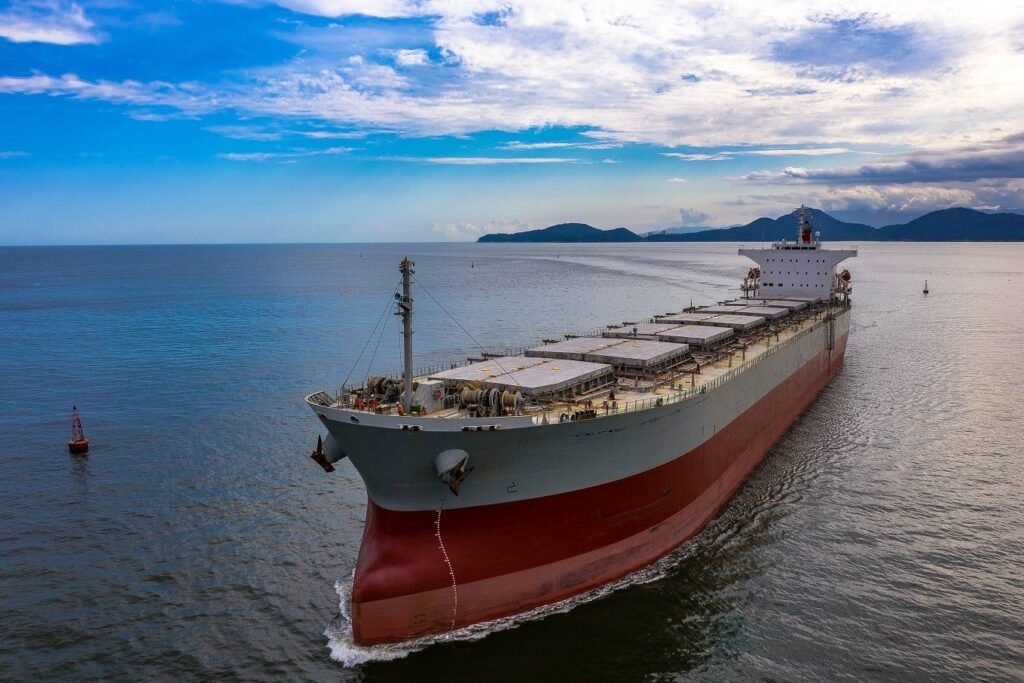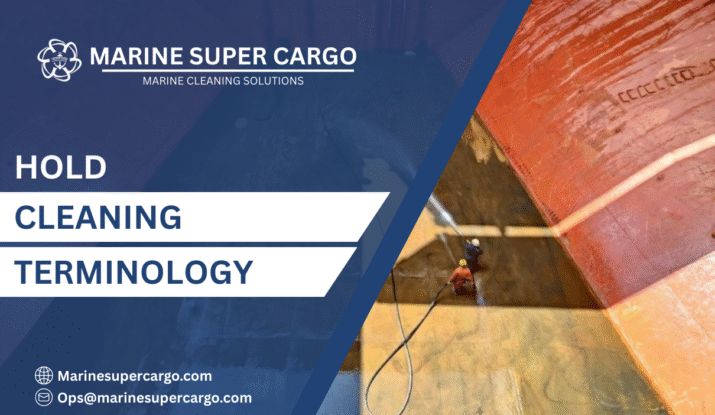Hold cleaning terminology encompasses the specialized vocabulary used throughout bulk carrier operations to describe cleaning procedures, equipment, standards, and compliance requirements. Understanding hold cleaning terminology ensures clear communication between crew members, surveyors, and commercial stakeholders. Professional mastery of hold cleaning terminology prevents misunderstandings that could compromise cargo operations.
Marine Super Cargo recognizes that proper hold cleaning terminology forms the foundation for effective operational procedures and regulatory compliance. The complexity of modern hold cleaning terminology reflects evolving industry standards, environmental regulations, and technological advances affecting bulk carrier operations.
Basic Hold Structure Terminology
Cargo Hold Components
Tank Top: The bottom plating of cargo holds that forms the structural foundation for cargo storage and provides access to bilge systems throughout the vessel’s length from forward to aft compartments.
Bilge Wells: Drainage collection points located at the lowest areas of cargo holds, typically positioned at regular intervals along both port and starboard sides to facilitate water removal during cleaning operations.
Hatch Coamings: Raised structural frameworks surrounding cargo hold openings that prevent water ingress while providing attachment points for hatch covers and cargo handling equipment.
‘Tween Decks: Intermediate deck spaces between main cargo holds and upper deck areas that may require cleaning when used for cargo storage or equipment access.
Marine Super Cargo emphasizes understanding these structural terms as they define specific cleaning requirements and inspection focus areas throughout bulk carrier operations.
Hold Access and Safety Terms
Confined Space: Any cargo hold or compartment with limited entry and exit points requiring specialized safety procedures, atmospheric testing, and emergency response protocols during cleaning operations.
Ventilation System: Mechanical systems that provide air circulation throughout cargo holds, essential for maintaining safe atmospheric conditions during cleaning and subsequent cargo operations.
Access Ladder: Fixed or portable ladder systems providing safe entry and exit from cargo holds during cleaning operations and cargo handling procedures.

Cleaning Standards and Specifications
Cleanliness Levels
Shovel Clean: Basic cleaning standard requiring removal of loose cargo residues without extensive washing, typically applied when loading similar cargo types with minimal contamination risk.
Swept Clean: Enhanced cleaning standard involving systematic removal of all loose materials using mechanical and manual cleaning methods throughout all accessible hold surfaces.Hold cleaning terminology
Water Washed: Comprehensive cleaning standard requiring pressurized water washing of all hold surfaces to remove adherent residues and contamination that dry cleaning cannot eliminate.
Grain Clean: The highest cleaning standard requiring complete elimination of all foreign matter to meet international food safety requirements for grain transportation operations.
Hospital Clean: Ultra-high cleaning standard establishing sterile conditions suitable for pharmaceutical products and ultra-sensitive commodities requiring absolute contamination elimination. Hold cleaning terminology
Cargo Compatibility Terms
Compatible Cargoes: Bulk commodities that can be loaded in sequence without intermediate cleaning, typically involving similar materials with minimal cross-contamination risk.
Incompatible Cargoes: Commodities requiring intensive cleaning between loadings due to contamination risks, regulatory requirements, or commercial quality concerns.
Cargo Succession: The sequence of different cargo types loaded in specific holds over multiple voyages, determining cleaning requirements and operational procedures. Hold cleaning terminology
Equipment and Procedures
Cleaning Equipment Terminology
High-Pressure Water System: Specialized cleaning equipment delivering pressurized water for removing stubborn residues from hold surfaces, typically operating at pressures exceeding 100 bar.
Industrial Vacuum System: Powerful suction equipment designed for removing loose materials, dust, and water from cargo holds during cleaning operations. Hold cleaning terminology
Portable Lighting: Specialized illumination equipment ensuring adequate visibility during cleaning operations in cargo holds where natural lighting may be insufficient.
Atmospheric Monitoring Equipment: Electronic devices measuring oxygen levels, toxic gases, and hydrocarbon concentrations to ensure safe working conditions during cleaning operations.
Chemical and Material Terms
Biodegradable Detergents: Environmentally friendly cleaning agents that break down naturally without causing marine pollution, preferred for bulk carrier cleaning operations.
Degreasing Agents: Specialized chemicals designed to remove oil, grease, and hydrocarbon residues from hold surfaces when water-based cleaning proves insufficient.
Disinfectants: Chemical agents used to eliminate bacteria, fungi, and other microorganisms when cleaning holds for food-grade commodity transportation.
Neutralizing Agents: Chemicals used to counteract acidic or alkaline residues from previous cargoes, particularly important when transitioning between chemical cargoes.
Survey and Inspection Terminology
Documentation Terms
Hold Inspection Certificate: Official document issued by qualified surveyors certifying that cargo holds meet specified cleanliness standards for intended cargo operations.
Cleaning Log: Detailed record documenting cleaning procedures, materials used, personnel involved, and time requirements for each cleaning operation. Hold cleaning terminology
Photographic Evidence: Digital images documenting hold conditions before, during, and after cleaning operations, providing permanent records for survey and commercial purposes.
Atmospheric Test Results: Documented measurements of air quality within cargo holds, including oxygen levels, toxic gas concentrations, and hydrocarbon vapor readings.
Survey Terminology
Pre-Loading Survey: Inspection conducted before cargo operations commence to verify hold readiness and cleaning compliance with charter party requirements.
Joint Survey: Inspection involving multiple parties including vessel representatives, cargo interests, and independent surveyors to establish agreed hold conditions.
Hold Condition Survey: Detailed assessment of structural conditions, cleanliness levels, and cargo readiness throughout all compartments. Hold cleaning terminology
Damage Survey: Investigation of cargo contamination incidents or structural problems affecting hold conditions and operational capabilities.
Regulatory and Compliance Terms
Environmental Terminology
MARPOL Compliance: Adherence to International Convention for the Prevention of Pollution from Ships regarding waste discharge and environmental protection during cleaning operations.
Wash Water Management: Procedures for collecting, treating, and disposing of contaminated water generated during hold cleaning operations in compliance with environmental regulations.
Waste Disposal Certificate: Documentation proving proper disposal of solid waste and contaminated materials generated during cleaning operations. Hold cleaning terminology
Discharge Standards: Specific limits for pollutants in wash water that may be discharged overboard in compliance with international environmental regulations.
Charter Party Terms
Hold Delivery Condition: Contractual specification of cleanliness standards required when delivering vessel to charterers for cargo operations. Hold cleaning terminology
Cleaning Cost Allocation: Charter party provisions determining which party bears responsibility for specific cleaning expenses based on cargo succession and operational requirements.
Time Allowance: Contractual provisions specifying time allocated for cleaning operations and how delays affect laytime calculations and demurrage obligations. Hold cleaning terminology
Operational and Commercial Terms
Time and Scheduling
Cleaning Time: Period required to complete specified cleaning operations, varying based on cleaning standards, hold size, and contamination levels.
Drying Time: Period required for holds to achieve appropriate moisture levels following water-based cleaning operations before cargo loading can commence.
Survey Time: Duration required for completing inspection procedures and obtaining necessary certificates before cargo operations can proceed.
Cost and Commercial Terms
Cleaning Expenses: Direct costs associated with labor, materials, equipment, and services required for hold cleaning operations.
Delay Costs: Financial consequences of extended cleaning operations including demurrage, lost hire, and opportunity costs affecting vessel utilization.
Contamination Penalties: Financial liabilities arising from inadequate cleaning including cargo claims, survey costs, and operational disruptions.
Quality Control and Performance
Measurement and Standards
Cleanliness Verification: Systematic procedures for confirming that cleaning operations have achieved specified standards through visual inspection and testing.
Performance Metrics: Quantitative measures of cleaning effectiveness including time efficiency, cost control, and compliance rates across fleet operations.
Quality Assurance: Systematic procedures ensuring consistent cleaning standards and performance across all vessels and operational scenarios.
Technology Integration
Digital Documentation: Electronic systems for recording, storing, and accessing cleaning records, survey reports, and compliance documentation.
Remote Monitoring: Advanced systems enabling shore-based oversight of vessel cleaning operations and performance verification.
Automated Reporting: Electronic systems generating standardized reports documenting cleaning procedures and compliance verification for regulatory and commercial purposes.
Conclusion
Mastering hold cleaning terminology is essential for professional bulk carrier operations in today’s sophisticated maritime industry. This specialized vocabulary facilitates clear communication while ensuring consistent application of cleaning standards and regulatory compliance requirements.
Marine Super Cargo continues supporting maritime professionals in understanding and applying proper hold cleaning terminology throughout diverse operational scenarios. Professional vocabulary usage demonstrates competency while preventing misunderstandings that could compromise operational success.
Investment in proper terminology training and consistent application ensures effective communication between all stakeholders while supporting safe, efficient, and compliant bulk carrier operations worldwide.
Frequently Asked Questions
1. What’s the difference between “swept clean” and “water washed” standards?
Swept clean involves mechanical removal of loose materials without water usage, suitable for compatible cargo transitions. Water washed requires pressurized water cleaning to remove adherent residues, necessary for incompatible cargo sequences or when higher cleanliness standards are required.
2. What does “grain clean” standard specifically require?
Grain clean standard requires complete elimination of all foreign matter including dust, residues, pest traces, and contamination sources. It involves multiple cleaning stages, disinfection procedures, and independent verification to meet international food safety standards for grain transportation.
3. How do “compatible” and “incompatible” cargoes affect cleaning requirements?
Compatible cargoes (like coal to coal) may only require shovel or swept clean standards. Incompatible cargoes (like coal to grain) require intensive cleaning including water washing and possibly grain clean standards to prevent contamination.
4. What documentation is typically required for hold cleaning compliance?
Required documentation includes cleaning logs, photographic evidence, atmospheric test results, hold inspection certificates, waste disposal records, and equipment maintenance logs. These documents provide audit trails for regulatory compliance and commercial protection.
5. What role do “bilge wells” play in hold cleaning terminology?
Bilge wells are drainage collection points at the lowest areas of cargo holds. They’re critical cleaning focus areas as blocked or contaminated bilge wells can compromise entire cleaning operations and affect cargo quality during loading and transport.


